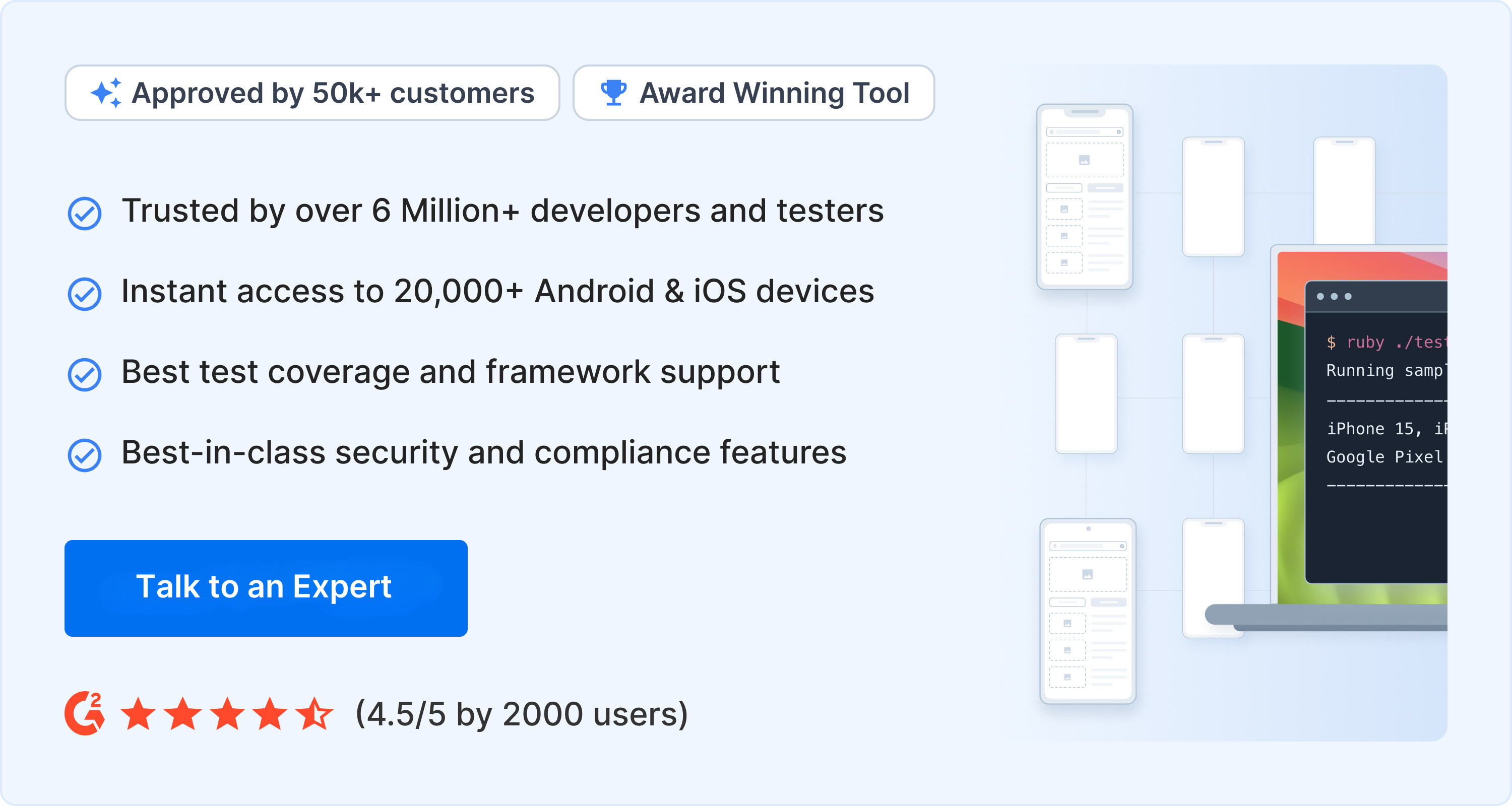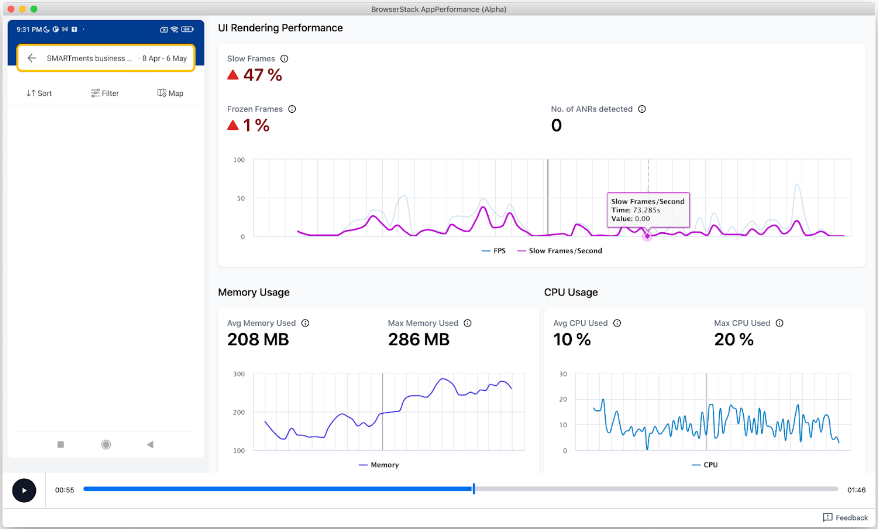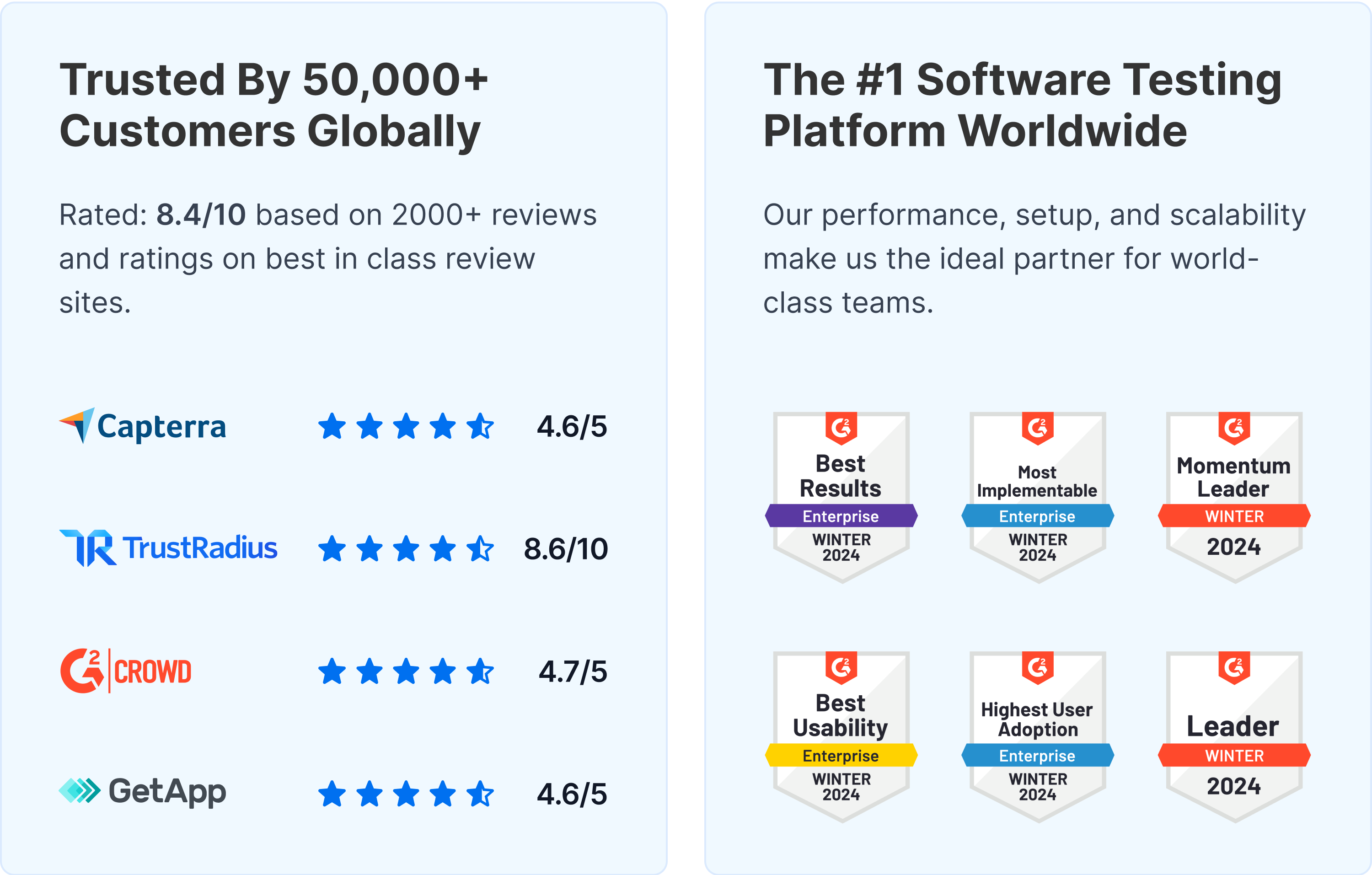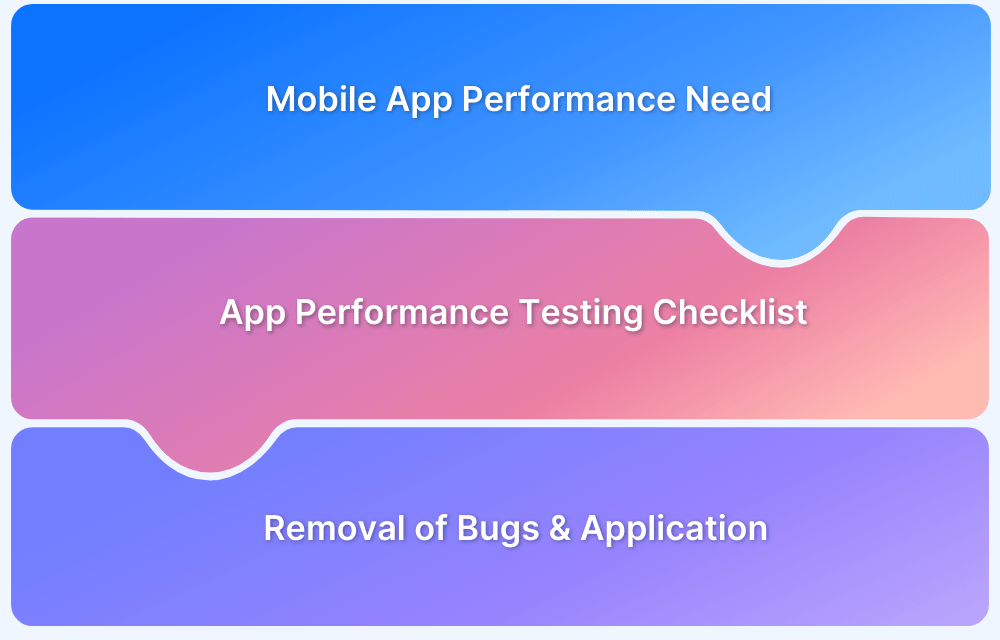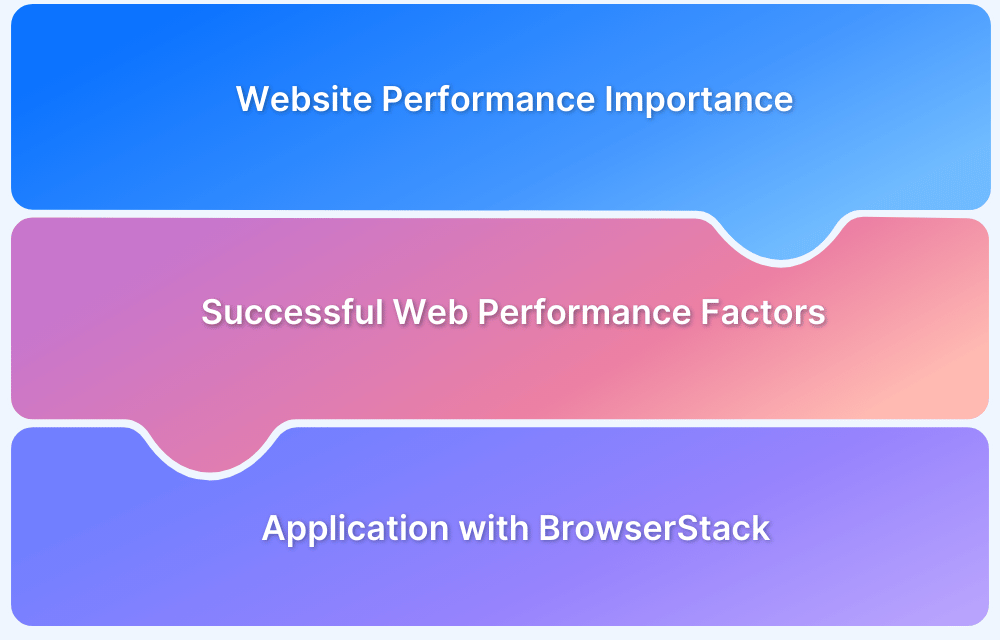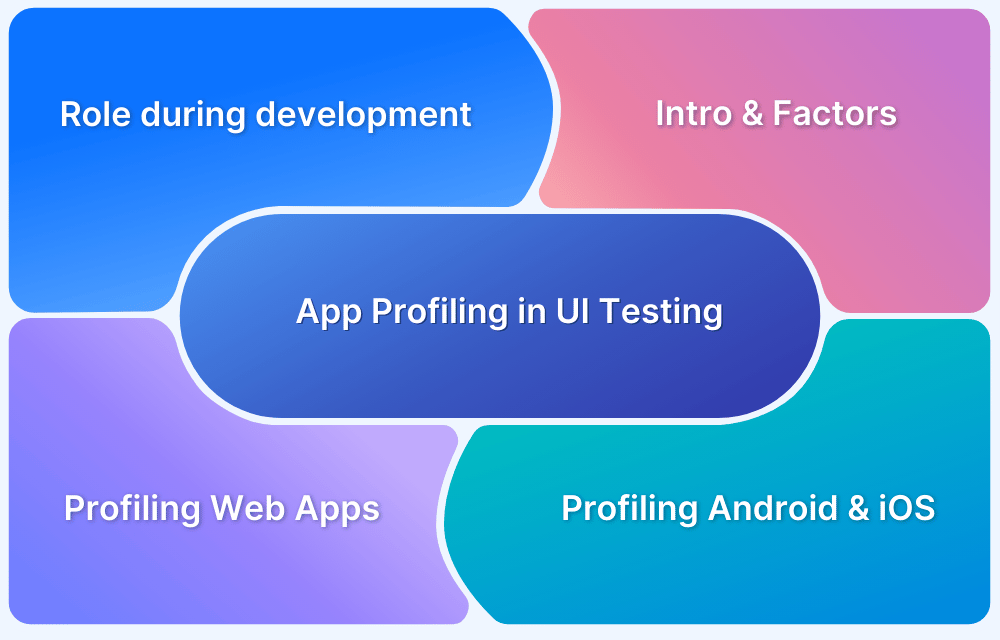Performance testing plays a crucial role in evaluating the performance of a web or mobile application.
It involves assessing various aspects of performance, such as speed, scalability, stability, and responsiveness under different workloads. By conducting performance testing, organizations can identify bottlenecks, determine system capacity, and optimize performance to deliver a better user experience.
Overview
Why conduct Performance Testing?
- Ensures system reliability under load
- Optimizes speed and resource usage
- Improves user experience
- Tests scalability for future growth
- Reduces risk of failures and downtime
Top 20 Performance Testing Tools
- Apache JMeter
- Gatling
- BrowserStack App Performance
- BrowserStack Automate
- LoadRunner
- BlazeMeter
- Locust
- K6
- Apache Bench (ab)
- NeoLoad
- Tsung
- WebLOAD
- Selenium
- Dynatrace
- Artillery
- New Relic
- AppDynamics
- Sitespeed.io
- Puppeteer WebPerf
- Siege
This article explores the role of performance testing and get an overview of some top performance testing tools that your QA team can choose from.
What is Performance Testing?
Performance testing is a type of testing that focuses on evaluating the performance characteristics of a system, software application, or website. The primary objective of performance testing is to identify any bottlenecks or performance issues and determine the system’s behavior under normal, peak, and stress conditions.
- It involves measuring and assessing various performance metrics, such as response time, throughput, resource utilization, and scalability, under different workloads and conditions.
- Realistic scenarios are simulated in performance testing to replicate user interactions and system usage. This can include simulating a specific number of concurrent users, generating high requests, or subjecting the system to extreme workloads.
- By conducting performance testing, organizations can gain insights into the system’s performance characteristics and identify areas for improvement.
It can be conducted at different phases of SDLC to detect performance issues early on, allowing developers to address them proactively. By identifying and resolving performance bottlenecks early, organizations can save time, effort, and costs to fix performance problems in later stages.
Also Read: What to consider during Web Performance Testing?
Why is a Performance Testing tool needed?
Here are the reasons why you must use a performance testing tool:
1. Simulate Real-World Load
Performance testing tools simulate real user activity at scale, helping you understand how your system behaves when thousands of users interact with it simultaneously. This prepares your app for real-world usage spikes and traffic surges.
2. Detect Performance Bottlenecks
They help uncover hidden performance issues such as slow database queries, memory leaks, or inefficient code paths. Identifying these bottlenecks early ensures smoother user experiences and better system efficiency.
3. Measure System Metrics
Tools collect vital performance data like response times, request rates, CPU and memory usage. This helps teams analyze system behavior under various conditions and fine-tune components for optimal performance.
4. Regression Prevention
By running consistent performance tests, you can detect if recent changes have slowed down the application. This ensures that software updates don’t unintentionally reduce speed or reliability.
5. Prevent Downtime
Performance tools help forecast and prevent crashes or slowdowns during heavy usage periods. This is especially important for high-stakes environments like online stores or financial platforms.
6. Meet SLAs (Service-Level Agreements)
Many businesses must guarantee uptime and speed. Performance testing proves the system can meet these expectations, ensuring compliance with client contracts and internal benchmarks.
7. Validate Scalability
These tools help test how well your app scales as user load increases. Whether it’s horizontal scaling with new servers or vertical scaling of resources, you can plan infrastructure intelligently.
8. Optimize Costs
Performance testing tools highlight inefficient use of resources, enabling teams to right-size infrastructure. This avoids overpaying for unused capacity or underpowering critical services.
Types of Performance Testing
There are several types of performance testing, each focusing on different aspects of system performance. It’s important to note that these types of performance testing are not mutually exclusive, and multiple types can be combined based on specific testing goals and requirements.
The main types of performance testing are:
- Load Testing: evaluates the system’s behavior under normal and peak load conditions. It simulates realistic user loads to assess the system’s performance, response times, resource utilization, and throughput.
- Stress Testing: involves subjecting the system to extreme workloads and identify the system’s breaking point, observe how it recovers from failures.
- Soak Testing: involves running a system under a significant load for an extended period to identify any performance degradation or issues that occur over time.
- Spike Testing: evaluates the system’s ability to handle sudden and significant increases in workload or user traffic.
- Scalability Testing: assesses how well the system can scale up or down to handle varying workloads or user demands. It helps determine the system’s performance as the load increases or decreases.
- Volume Testing: involves testing the system’s performance when subjected to large volumes of data.
- Isolation Testing: involves testing individual components or modules of the system in isolation to assess their performance and identify any performance issues.
What is a Web App Performance Testing Tool?
A Web App Performance Testing Tool is a software solution designed to evaluate the speed, responsiveness, stability, and scalability of a web application under various conditions.
It simulates real-world traffic, user interactions, and network scenarios to identify performance bottlenecks. It ensures the web app delivers a smooth experience across devices and browsers.
Key Functions:
- Measure page load time, render speed, and interaction responsiveness
- Simulate concurrent users and traffic spikes
- Monitor frontend performance (for example, Lighthouse metrics) and backend health
- Identify issues like slow API responses, memory leaks, or high server load
- Provide actionable insights for optimizing performance before production
Web App Performance Testing Tool vs Mobile App Performance Testing Tool
Web app performance testing tools focus on how quickly and reliably a site loads and runs in a browser. On the other hand, mobile app performance tools go deeper into device-level performance, accounting for hardware, sensors, and OS behavior.
Here are some of the key differences:
| Aspect | Web App Performance Testing Tool | Mobile App Performance Testing Tool |
|---|---|---|
| Purpose | Test performance of web applications across browsers and devices | Test performance of mobile apps across real mobile devices and networks |
| Platform | Browsers (Chrome, Firefox, Safari, etc.) | Mobile operating systems (iOS, Android) |
| Metrics Tracked | Page load time, Time to Interactive, First Contentful Paint, JS errors | App launch time, FPS, ANR rate, battery usage, memory & CPU consumption |
| Network Simulation | Simulate different internet speeds and latency | Simulate 3G/4G/WiFi with real signal fluctuation |
| Device Testing | Runs on virtual or real browsers | Runs on real mobile devices (smartphones, tablets) |
| Tools Examples | Lighthouse, WebPageTest, GTmetrix, BrowserStack Automate | BrowserStack App Performance, Gatling, etc |
| User Interaction Simulation | Automated browser-based testing using scripts | Simulate user flows, gestures, and hardware interactions |
| Use Cases | Ensure fast load times, compatibility, and responsiveness on web | Optimize app performance, energy use, and crash resilience on mobile |
Top 20 Performance Testing Tools in 2025
With this understanding of the importance of performance testing, let’s delve into the top performance testing tools.
1. Apache JMeter
Apache JMeter is a powerful open-source tool developed by the Apache Software Foundation. It is widely used for load and performance testing of web applications, APIs, databases, and other server-based systems. JMeter allows you to simulate various scenarios and generate loads to assess the system’s performance under different conditions.
JMeter’s key objective is to evaluate how well a system can handle a specific workload, measure response times and throughput, and identify performance bottlenecks.
Key Features and Capabilities:
- Enables distributed testing for realistic load generation across multiple machines.
- Supports a wide range of protocols, including HTTP, HTTPS, SOAP, JDBC, and FTP, for comprehensive performance testing of various applications and APIs.
- Extensive reporting and analysis features with graphical representations to identify performance bottlenecks.
- The user-friendly interface allows easy script creation and customization using GUI or scripting with Groovy.
- The plugin ecosystem enhances JMeter’s functionality with advanced features.
Compatibility:
- Compatible with Windows, macOS, and Linux
- Supports testing of popular web servers like Apache, Nginx, and IIS, as well as databases such as MySQL, Oracle, and PostgreSQL.
Integration:
- Offers seamless CI/CD integration, allowing performance testing within automated build and deployment processes.
- Its integration with Selenium enables comprehensive testing, combining functional and performance evaluations for web applications.
- Compatibility with APM tools facilitates monitoring and analyzing the entire application stack, providing a holistic performance view.
2. Gatling
Gatling is an open-source load-testing tool that is designed to help testers and developers assess the performance and scalability of web applications. It is known for its efficient resource utilization, high performance, and ability to handle large concurrent user loads.
Gatling is built on the principles of asynchronous and non-blocking I/O, allowing it to generate high loads without overwhelming system resources.
Key Features and Capabilities:
- Offers a DSL that simplifies test script creation, making scenarios more readable and maintainable.
- Provides real-time monitoring and reporting of key performance metrics like response times and error rates for quick bottleneck identification.
- Allows for efficiently handling thousands of concurrent users, aiding accurate performance assessment under heavy loads.
- Advanced simulation features like custom behaviors and pacing help create complex and realistic load scenarios.
- Seamless integration with popular IDEs enhances test script development, improving tester productivity.
Compatibility:
- Optimized for load testing web applications, supporting HTTP, HTTPS, and WebSocket protocols for testing diverse web-based systems.
- Compatible with various web browsers and operating systems, enabling testers to assess application performance across different environments.
Integration:
- Integrates with popular build tools like Maven and Gradle, simplifying test execution and workflow incorporation.
- Seamless integration with CI/CD tools such as Jenkins and Bamboo allows automated performance testing within continuous integration and delivery pipelines.
- Gatling supports integration with APM tools, combining load testing results with real-time application infrastructure data for comprehensive performance monitoring.
3. BrowserStack Automate
BrowserStack Automate is a powerful testing platform that now offers integrated web app performance testing using Lighthouse in combination with Playwright automation.
It enables developers and QA teams to assess the performance of web applications across real browsers and devices and ensures fast, stable, and responsive user experiences.
By leveraging BrowserStack’s cloud infrastructure, teams can run automated tests while capturing core performance metrics, including page load times, Lighthouse scores, and more—without the need for local setup or infrastructure.
Key Features and Capabilities:
- Run automated Playwright tests on 3500+ real desktop and mobile browsers via BrowserStack’s secure cloud.
- Collect Lighthouse reports during test runs to monitor performance indicators like First Contentful Paint and Time to Interactive.
- To gain real-world performance insights, generate page load performance reports automatically for each session.
- Access detailed network logs, console logs, screenshots, and performance data for effective debugging.
- Integrate easily with CI/CD tools like Jenkins, GitHub Actions, and CircleCI for continuous performance tracking.
Compatibility:
- Fully compatible with web applications across browsers like Chrome, Firefox, Safari, and Edge.
- It supports modern frameworks, including Playwright, Selenium, and more.
- Offers cross-platform support across Windows, macOS, Android, and iOS devices, helping ensure consistent performance across environments.
Integration:
- Simply set a flag in your Playwright test configuration to enable Lighthouse metrics generation, with no extra setup required.
- BrowserStack Automate can be easily plugged into popular CI tools like GitHub Actions, Jenkins, GitLab, and Bitbucket.
- Share performance reports with stakeholders using public URLs, or integrate alerts and logs into tools like Slack, JIRA, and others for seamless workflows.
- Use the REST API to fetch performance reports, trigger tests, or embed insights into your dashboards and reporting systems.
4. BrowserStack App Performance
BrowserStack App Performance is a comprehensive performance testing tool designed to evaluate the performance of mobile applications. It allows testers to assess mobile apps’ responsiveness, speed, and stability under various conditions.
BrowserStack App Performance offers a comprehensive set of features to assess the performance of mobile applications. Its real-device testing, performance metrics, network condition simulation, user flow analysis, and real-time monitoring capabilities make it a valuable tool for ensuring the optimal performance of mobile apps across different devices and network conditions.
Key Features and Capabilities:
- Leverage the BrowserStack device cloud with 20,000+ real devices or test locally on your own device
- Track key user metrics such as FPS, ANR rate, App & page loading times, device resource usage and more in real-time for in-depth analysis.
- Simulate network conditions like 3G, 4G, and Wi-Fi to evaluate app performance under varying connectivity scenarios.
- User flow analysis helps identify performance issues in specific app interactions, optimizing critical user journeys.
- Performance comparison features enable an analysis of the impact of code changes or new features on app performance.
Compatibility:
- Compatible with both iOS and Android mobile apps, supporting various frameworks and technologies.
- Offers an extensive library of real devices covering multiple operating system versions, including smartphones and tablets.
- Testers can assess mobile app performance on a diverse set of real devices to ensure compatibility and performance across various configurations.
Integration:
- BrowserStack App Performance seamlessly integrates with Appium and Selenium, enabling combined performance and functional testing in existing automation workflows.
- It easily integrates with Jenkins, Bamboo, and TeamCity, allowing automated performance testing in continuous integration and delivery processes.
- Offers collaboration features, including sharing results with stakeholders and integrating with tools like Slack and JIRA for seamless communication.
- The tool provides an API for custom integration with third-party tools, enhancing the efficiency and flexibility of the testing process.
5. LoadRunner
LoadRunner is a performance testing tool developed by Micro Focus. It is designed to simulate real-world user traffic and test software applications’ performance, scalability, and reliability. LoadRunner supports a wide range of applications and protocols, including web applications, mobile applications, client-server applications, SOAP and REST web services, and more. It allows testers to create and execute load and stress tests to assess application performance under different loads and scenarios.
Key Features and Capabilities:
- Supports various protocols for realistic application simulation.
- It can handle large user loads with scalability for distributed testing.
- Powerful scripting language enables the customization of scenarios.
- Real-time monitoring aids in identifying performance issues during testing.
- Comprehensive analysis and reporting assist in optimizing performance.
Compatibility:
- Compatible with Windows and Linux, supporting various operating systems, web servers, application servers, and databases.
- Supports testing web applications and frameworks like Java, .NET, and Oracle Forms, simulating user interactions to assess performance.
Integration:
- Integrates with Jenkins and Azure DevOps for automated performance testing in CI/CD pipelines.
- It supports APM tool integration for a holistic view of application performance and identifying bottlenecks.
- Test management integration ensures seamless test execution and result tracking within test management workflows.
6. BlazeMeter
BlazeMeter is a cloud-based load-testing platform that enables developers and testers to conduct application performance and load testing. It is owned by Broadcom (formerly known as CA Technologies).
With BlazeMeter, users can create and execute performance tests using popular open-source testing tools like Apache JMeter, Gatling, and Selenium WebDriver.
Key Features and Capabilities:
- Provides scalable load generation capabilities, allowing testers to simulate high user loads and assess system performance under various traffic conditions using cloud infrastructure.
- Supports popular scripting languages like JMeter, Gatling, and Selenium, and offers a user-friendly GUI-based editor for test scenario creation.
- Offers real-time monitoring and reporting features, displaying key performance metrics like response times, throughput, error rates, and server resource usage for efficient bottleneck identification and optimization decisions.
- Collaboration and team management features facilitate seamless cooperation among team members in test creation, execution, and analysis, fostering effective knowledge sharing.
Compatibility:
- Supports web and mobile applications across different platforms, allowing testing on various operating systems and browsers.
- It is compatible with various technology stacks and frameworks like Java, .NET, PHP, and Node.js, facilitating performance evaluation of applications built using different technologies.
Integration:
- Integrates with Jenkins, GitLab, and Bamboo for automated performance testing in the CI/CD pipeline, streamlining test execution and result management.
- It integrates with APM tools like New Relic and Dynatrace for comprehensive performance monitoring, combining load-testing results with infrastructure and application monitoring to identify bottlenecks across the entire stack.
7. Locust
Locust is an open-source, Python-based, and distributed load-testing tool used to measure the performance and scalability of web applications, APIs, and other network-based services. It is designed to be user-friendly, highly flexible, and scalable, making it a popular choice for load testing in various projects.
With Locust, developers and testers can simulate realistic user traffic and assess their applications’ performance under different load conditions.
Key Features and Capabilities:
- Locust uses Python, offering a straightforward and readable syntax for creating performance testing scenarios.
- Supports scalable load generation across multiple machines for realistic testing under heavy user traffic.
- Provides real-time monitoring on a web-based dashboard for instant performance insights during test execution.
- Its highly extensible architecture allows customization to meet specific testing requirements.
- Integrates with Gherkin for human-readable load test scenario descriptions, enhancing collaboration with non-technical stakeholders.
Compatibility:
- Compatible with web applications, supporting HTTP and HTTPS protocols for load testing on various web applications, APIs, and backend systems.
Integration:
- Integrates with Python, offering flexibility and access to Python libraries and tools for test data preparation and analysis.
- It can be integrated into CI/CD pipelines for automated performance testing alongside functional tests, ensuring comprehensive testing throughout the software development lifecycle.
- Locust’s plugin system allows testers to create custom plugins for added features, external system integration, and enhanced reporting capabilities.
Read More: Guide to UI Performance Testing
8. K6
K6 is an open-source, developer-centric, and performance testing tool designed for load testing and performance testing of web applications and APIs. It allows developers and testers to measure the performance and scalability of their systems under different load conditions.
K6 is known for its simplicity, extensibility, and integration with the modern development ecosystem.
Key Features and Capabilities:
- k6 uses JavaScript for test script creation, making it user-friendly for JavaScript experts.
- It generates high loads and scales across multiple virtual machines to replicate real-world user behavior.
- k6 provides real-time monitoring and live test result analysis for instant performance issue identification.
- Being open-source, k6 allows customization and development of custom plugins for extended functionality.
- k6 supports performance checks and thresholds to validate system behavior and set pass or fail criteria.
Compatibility:
- k6 supports APIs and web applications with standard HTTP/1.1 and HTTP/2 protocols for performance testing.
- It allows testing of RESTful APIs, microservices, and web applications using HTTP requests.
Integration:
- k6 integrates with popular CI/CD tools like Jenkins, GitLab, and Travis CI for automated performance testing in the development lifecycle.
- It integrates with platforms like Grafana Cloud and k6 Cloud, providing additional result storage, analysis, and sharing capabilities
- k6 has built-in support for load testing GraphQL APIs, allowing testers to simulate complex queries and mutations in GraphQL-based applications.
9. Apache Bench
ApacheBench (ab) is a command-line tool and open-source software from the Apache HTTP server project. It is used for load-testing web servers and applications by measuring their performance and concurrency under different conditions.
ApacheBench is designed to be a simple tool for quick performance testing without complex setups or configurations.
Key Features and Capabilities:
- Offers an easy-to-use command-line interface, making it accessible to testers and developers.
- Generates requests to a target URL, simulating multiple concurrent users for performance evaluation.
- Provides basic performance metrics like requests per second and response time for quick performance assessment.
Compatibility:
- Apache Bench is compatible with web servers supporting HTTP and HTTPS protocols.
- It can benchmark web servers on various platforms and technologies.
Integration:
- Apache Bench is a standalone tool, primarily used for quick and straightforward performance benchmarking.
- Testers can export benchmarking results for further analysis using external tools like spreadsheets or data analysis software to generate graphs or charts.
10. NeoLoad
NeoLoad is a performance testing tool developed by Neotys. It is designed to assess the performance and scalability of web applications, APIs, and other network-based services. NeoLoad allows developers and testers to simulate user traffic, measure system behavior under load, and identify performance bottlenecks.
It is known for its user-friendly interface, advanced testing capabilities, and support for various technologies. NeoLoad offers comprehensive performance testing solutions for web and mobile applications, web services, streaming protocols, and more.
Key Features and Capabilities:
- Intuitive GUI simplifies test creation, accessible to testers of varying expertise.
- It offers user path and logical actions for realistic and complex scenarios.
- Live dashboards display critical performance metrics during test execution.
- Supports sharing scenarios, results, and reports among team members.
Compatibility:
- Supports web and mobile applications with HTTP and HTTPS protocols for performance testing.
- It can handle applications developed in Java, .NET, PHP, Node.js, and more.
Integration:
- Integrates with AWS and Azure for additional load generation capacity and scalability.
- Integrates with Dynatrace and AppDynamics for comprehensive performance insights.
- Integrates with test management systems for comprehensive test management.
11. Tsung
Tsung is an open-source, distributed load-testing tool used for performance testing and benchmarking web applications, web services, and other network protocols. Developed in Erlang, Tsung is designed to generate high concurrency and stress on the system under test, enabling users to assess its performance and scalability.
Key Features and Capabilities:
- Allows simulating massive virtual users across multiple machines for accurate and scalable load testing.
- Supports various protocols for diverse application testing, including HTTP, WebSockets, MQTT, and more.
- Tsung’s XML-based format enables custom test scenarios and realistic user behaviors.
- Provides real-time performance metrics and reporting during load tests.
- Allows customization and integration with other systems or tools.
Compatibility:
- Supports various web and application protocols, including HTTP, HTTPS, and messaging protocols.
- Suitable for testing a wide range of applications and services.
Integration:
- Tsung is a standalone tool executed from the command-line interface, offering various options for test execution, report generation, and configuration updates.
- Can integrate with external monitoring tools like Grafana, InfluxDB, or Prometheus, enhancing its monitoring and analysis capabilities during load tests.
- Allows testers to export test results in XML or CSV formats for further analysis using external tools or data analysis software.
Read More: Understanding the Basics of Web Performance
12. WebLOAD
WebLOAD is a high-performance load testing solution tailored for enterprise-grade web applications. It allows you to simulate large-scale user traffic and measure how your application performs under heavy loads. WebLOAD is known for its ability to create realistic testing scenarios that closely mirror real-world conditions, making it ideal for stress testing and performance optimization.
Key Features and Capabilities:
- Accurately simulates user behavior across different network conditions to assess the scalability of your web applications.
- Supports both cloud-based and on-premise load testing, giving flexibility in deployment options.
- Offers flexibility in creating test scripts using JavaScript, enabling complex scenarios and customization.
- Provides in-depth analytics, including performance metrics, bottleneck identification, and capacity planning.
Compatibility:
- Designed for testing web applications across various browsers, including those on mobile devices, ensuring comprehensive coverage.
Integration:
- Seamlessly integrates with CI/CD tools like Jenkins, and monitoring platforms such as Dynatrace and New Relic, to support continuous testing and monitoring processes.
13. Selenium
Selenium is a widely-used, open-source automation tool designed for testing web applications across various browsers and platforms. Its primary strength lies in its ability to automate browser actions, making it a cornerstone for functional and regression testing in web development.
Key Features and Capabilities:
- Automates tests across all major browsers (Chrome, Firefox, Safari, Edge) and operating systems (Windows, macOS, Linux).
- Compatible with popular programming languages like Java, C#, Python, and more, allowing teams to work in their preferred coding environment.
- The robust ecosystem of plugins and frameworks (e.g., Selenium Grid, Appium) extends its functionality, making it suitable for mobile testing as well.
- Supports running multiple tests simultaneously, significantly reducing testing time.
Compatibility:
- Works across all major browsers, operating systems, and supports integration with mobile testing tools for comprehensive test coverage.
Integration:
- Easily integrates with CI/CD pipelines using Jenkins, Bamboo, and other tools.
- Works well with test frameworks like TestNG, Maven and JUnit for enhanced test management.
Read More: What is Android Performance Testing?
14. Dynatrace
Dynatrace is a leading application performance management (APM) solution that leverages artificial intelligence (AI) to provide deep insights into application performance, user experience, and infrastructure health. It automates the monitoring process, allowing teams to proactively identify and resolve issues before they impact users.
Key Features and Capabilities:
- Monitors every layer of the application stack, including servers, databases, and user experience, providing a complete performance picture.
- Automatically detects and diagnoses performance issues, offering actionable insights to resolve them quickly.
- Tracks every transaction across distributed systems, helping to identify and address bottlenecks and latency issues.
- Provides real-time insights into user interactions, ensuring that applications deliver optimal user experiences.
Compatibility:
- Supports a wide range of environments, including cloud-native (AWS, Azure, Google Cloud), on-premises, and hybrid infrastructures, making it versatile for different deployment models.
Integration:
- Offers extensive integration options with cloud platforms, CI/CD pipelines, DevOps tools, and IT service management (ITSM) tools like ServiceNow, ensuring smooth deployment and monitoring across the entire software lifecycle.
15. Artillery
Artillery is an open-source load testing and functional testing toolkit designed for modern web applications, including APIs and microservices. It is lightweight yet powerful, offering the ability to simulate high-traffic scenarios and validate the performance and scalability of your services.
Key Features and Capabilities:
- Allows users to create detailed test scenarios using JavaScript, enabling complex and customized performance tests.
- Supports multiple protocols, including HTTP, WebSocket, and Socket.io, making it versatile for different types of applications.
- Capable of generating large-scale loads from distributed environments, ensuring your application can handle peak traffic.
- Offers detailed performance reports, including latency, error rates, and throughput, helping to identify and resolve performance issues.
Compatibility:
- Designed for testing web APIs, microservices, and HTTP-based applications, making it suitable for modern, distributed architectures.
Integration:
- Works well with CI/CD pipelines, Docker, and cloud services like AWS Lambda, allowing for automated and scalable performance testing.
16. New Relic
New Relic is a comprehensive observability platform that provides real-time monitoring and diagnostics across the entire technology stack. It offers detailed insights into application performance, user experience, and infrastructure health, helping teams quickly identify and resolve issues.
Key Features and Capabilities:
- Continuously monitors application performance, providing real-time insights into response times, throughput, and error rates.
- Tracks transactions across microservices, identifying performance bottlenecks and ensuring smooth operation.
- Allows users to create custom dashboards and set up alerts for critical performance metrics, ensuring proactive management.
- Monitors the health of servers, databases, and cloud environments, providing a unified view of the entire infrastructure.
Compatibility:
- Supports a wide range of deployment models, including cloud, on-premises, and hybrid environments, and is compatible with numerous languages and frameworks.
Integration:
- Integrates seamlessly with AWS, Azure, Google Cloud, Kubernetes, and popular DevOps tools, enabling end-to-end monitoring and performance management across your entire stack.
17. AppDynamics
AppDynamics is an advanced application performance management (APM) solution that provides end-to-end visibility into your application’s performance, from code-level diagnostics to user experience monitoring. It helps organizations ensure their applications perform optimally, even under the most demanding conditions.
Key Features and Capabilities:
- Automatically maps application dependencies, providing a clear view of how different components interact and affect performance.
- Uses AI to establish performance baselines and detect anomalies, allowing for proactive issue resolution.
- Tracks user interactions with your application in real-time, helping to identify and resolve user experience issues.
- Provides deep diagnostics down to the code level, helping to quickly identify and resolve performance issues.
Compatibility:
- Compatible with cloud, on-premises, and hybrid environments, and supports a wide range of programming languages and frameworks.
Integration:
- Integrates with CI/CD tools like Jenkins and Bamboo, cloud platforms like AWS and Azure, and ITSM tools like ServiceNow, enabling comprehensive performance management throughout the application lifecycle.
18. Sitespeed.io
Sitespeed.io is an open-source tool that focuses on web performance testing and monitoring, helping developers optimize their web applications for better user experiences. It automates the process of collecting performance metrics and provides actionable insights to improve site speed and efficiency.
Key Features and Capabilities:
- Analyzes web pages for performance issues, providing recommendations for optimization based on industry best practices.
- Leverages Google’s Lighthouse and Browsertime for in-depth performance testing, including core web vitals.
- Can be set up to continuously monitor your website’s performance, alerting you to any degradation in speed or user experience.
- Offers Grafana dashboards that visualize performance data, making it easy to track and analyze trends over time.
Compatibility:
- Compatible with web applications across various browsers, allowing for broad testing Works across all major browsers and supports testing of web applications, single-page applications (SPAs), and APIs.
Integration:
- Integrates seamlessly with CI/CD tools like Jenkins and CircleCI, cloud platforms like AWS, and monitoring solutions like Prometheus and Grafana for a holistic approach to web performance optimization.
19. Puppeteer WebPerf
Puppeteer WebPerf is a specialized tool built on top of Puppeteer, designed for automating performance testing of web applications. By controlling a headless version of Chrome or Chromium, Puppeteer WebPerf enables developers to gather detailed performance metrics and identify potential bottlenecks.
Key Features and Capabilities:
- Allows for automated browsing and testing without a graphical interface, reducing resource consumption and improving test speed.
- Collects comprehensive performance data, including page load times, rendering speed, and script execution times.
- Enables users to create highly specific test scenarios using JavaScript, allowing for thorough performance testing.
- Captures screenshots and PDFs of web pages during performance tests, aiding in visual analysis and reporting.
Compatibility:
- Works with Chrome and Chromium-based browsers, making it ideal for testing web applications designed for these environments.
Integration:
- Easily integrates with CI/CD pipelines, Node.js environments for testing automation, and performance monitoring tools like Lighthouse for a holistic performance testing approach.
20. Siege
Siege is an open-source load testing and benchmarking tool designed for evaluating the performance of web servers. It allows you to simulate multiple users accessing your application simultaneously, providing valuable insights into how your server handles concurrent traffic.
Key Features and Capabilities:
- Simulates HTTP requests to your server, measuring response times, throughput, and error rates under load.
- Can simulate thousands of users hitting your server at the same time, testing its ability to handle high traffic.
- Provides real-time performance data, allowing you to monitor the server’s response to different load levels and make adjustments as needed.
- Offers benchmarking capabilities to compare the performance of different servers or configurations under identical conditions.
Compatibility:
- Compatible with any web server that supports HTTP, making it versatile for testing a wide range of web applications.
Integration:
- Easily integrated into CI/CD pipelines and automated testing workflows, with support for scripting and scheduling tests through its command-line interface.
How to select the best Performance Testing Tool?
Selecting the best performance testing tool requires careful consideration of various factors to ensure it aligns with your project’s specific needs and requirements.
Here are 10 essential steps to help you choose the right tool:
- Identify Testing Requirements
- Consider Compatibility
- Ease of Use
- Conduct Proof of Concept (POC)
- Community and Support
- Analyze Testing Features
- Scalability and Load Generation
- Integration Capabilities
- Reporting and Analysis
- Cost and Licensing
Conclusion
Performance testing is a critical aspect of software development that ensures applications meet performance requirements and deliver a seamless user experience.
Selecting the optimum tool for performance testing is crucial as it directly impacts project success and delivery expectations. By leveraging tools like BrowserStack App Performance, organizations can effectively assess the performance of their web and mobile applications and ensure a high-quality user experience.


